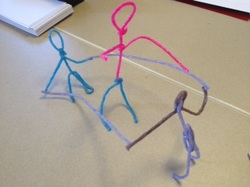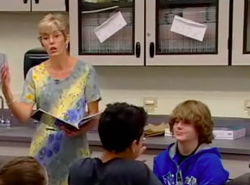
This photo shows three students playing double dutch, chanting "2, 4, 6, 8...." in their rhyme as they jump.
 I love Wikki Stix for encouraging students to develop abstract, symbolic representations of concepts. At a recent workshop with 4th grade math teachers, I asked them to use Wikki Stix to represent the concept of skip counting. Here are a few photos of their products! This photo shows three students playing double dutch, chanting "2, 4, 6, 8...." in their rhyme as they jump.
1 Comment
 One of my teammates has a student in her class this year that falls somewhere on the autism spectrum – location yet to be determined. He is a bright young man with loads of energy and an inquisitive mind. As Thomas Armstrong suggests, in a recent article in Educational Leadership, he is neurally diverse with many strengths. However, his diversity challenges teachers to think differently about ways to capture his interest. During a recent lesson, I happened to mention something about puzzles. This student impulsively shouted, “Puzzles? I love puzzles! They are my favorite things in the whole world.” Eureka! – an insight into a possible engagement strategy. My colleague snatched the ball and ran with it. She and her grade level partners developed an interactive approach that incorporated jigsaw puzzles. A science unit on animals became a puzzle piecing activity for all students, reinforcing the concepts of structures and connections. The targeted student was highly engaged, as were all the other students in the class. The teachers all agree that it was a successful approach that will be used again next year. Neural diversity brings much to a classroom. Celebrate it this week! P.S. We have also used an iPad app called JigsawBox that allows you to turn any photo into an interactive jigsaw puzzle. For more app ideas, join me at an IED seminar I will be offering in March on the Best Apps for Differentiating Instruction. Registration will begin in a few weeks for Indianapolis (3/18), Atlanta (3/19), Chicago (3/20 & 3/21) and Denver (3/22.)  This week I had the opportunity to work with ELL specialists and their co-teachers in Cherry Creek Schools. One of our activities involved generating higher level thinking questions to engage students. Below are some of the creative ideas the co-teachers developed. Try stuffing each one in an envelope and posting the envelopes on the walls of your classroom (as seen in the photo.) Near the end of the lesson, ask a student to randomly choose one of the envelopes and read the question aloud. A great way to stimulate interesting thought and discussion!
Recently I had the opportunity to co-teach in a class where students were learning about reading diagrams. Working in teams, they were supposed to assemble a complicated Lego toy by following one of the diagrams that had been provided. (The teacher had distributed diagrams at 3 differing reading levels.) Watching them, I realized that one group was struggling because the students did not have a strategy for effectively scanning the diagram for key information. They had ignored one very important section of the page.
Afterwards, the teacher and I had an opportunity for professional dialogue about the lesson. We discussed the fact that reading tasks are not always linear, or logical, in their directionality. We realized that it isn’t always enough to provide materials at different ability levels. We also need to teach strategic skills. We then developed the solution shown in the photo below. Using plastic report covers, we divided the page into four quadrants and numbered them (similar to a graph.) Students can scan strategically, teachers can talk about items in each quadrant, and students can even annotate. We also realized that these clear report covers could be used to teach students about how to scan web pages (see photo.) |
Anne M. BeninghofAnne's mission is to improve instruction through collaboration and the sharing of creative, practical ideas for educators. Archives
October 2022
Categories
All
|